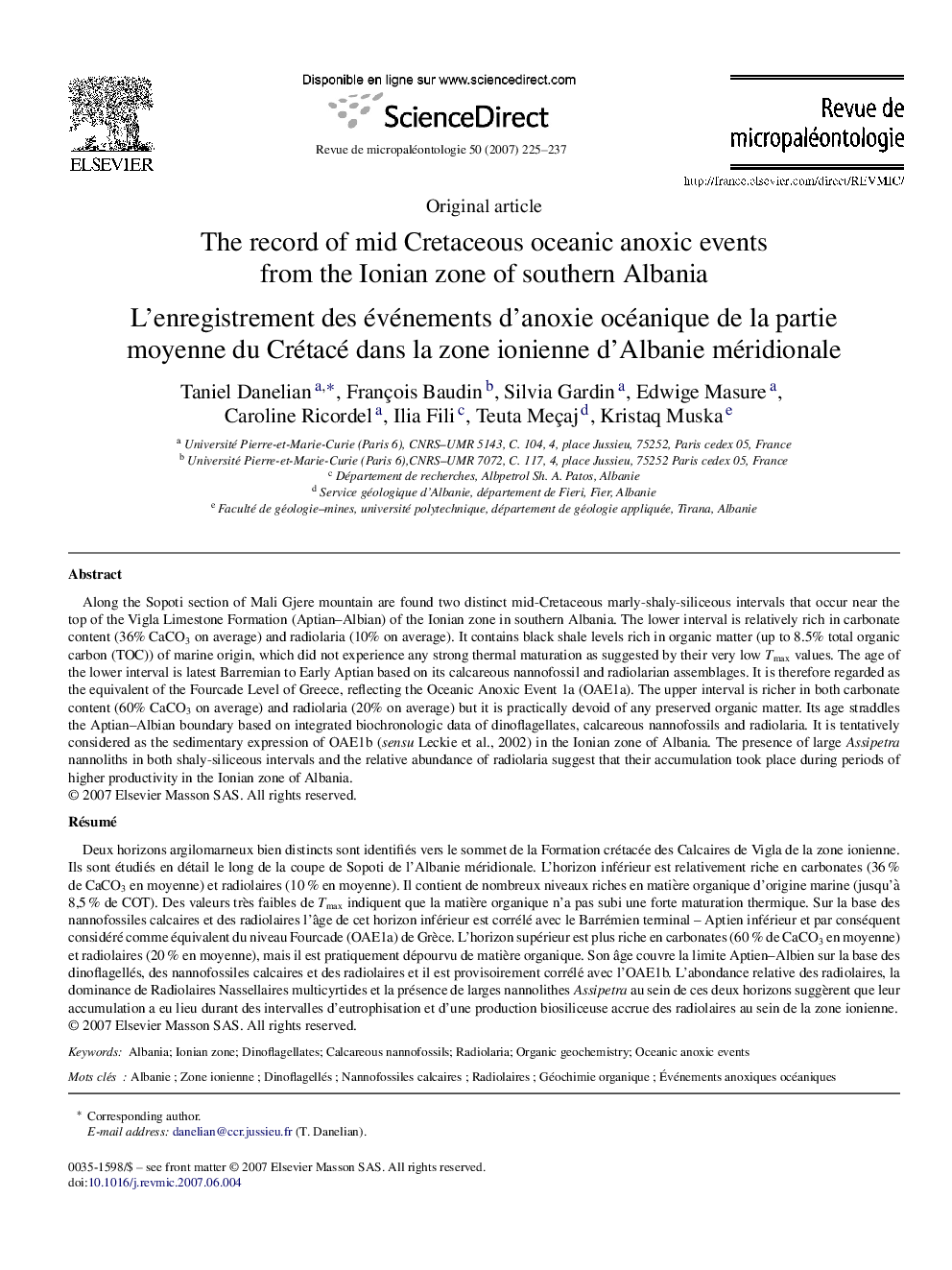| کد مقاله | کد نشریه | سال انتشار | مقاله انگلیسی | نسخه تمام متن |
|---|---|---|---|---|
| 4751599 | 1361090 | 2007 | 13 صفحه PDF | دانلود رایگان |

Along the Sopoti section of Mali Gjere mountain are found two distinct mid-Cretaceous marly-shaly-siliceous intervals that occur near the top of the Vigla Limestone Formation (Aptian–Albian) of the Ionian zone in southern Albania. The lower interval is relatively rich in carbonate content (36% CaCO3 on average) and radiolaria (10% on average). It contains black shale levels rich in organic matter (up to 8.5% total organic carbon (TOC)) of marine origin, which did not experience any strong thermal maturation as suggested by their very low Tmax values. The age of the lower interval is latest Barremian to Early Aptian based on its calcareous nannofossil and radiolarian assemblages. It is therefore regarded as the equivalent of the Fourcade Level of Greece, reflecting the Oceanic Anoxic Event 1a (OAE1a). The upper interval is richer in both carbonate content (60% CaCO3 on average) and radiolaria (20% on average) but it is practically devoid of any preserved organic matter. Its age straddles the Aptian–Albian boundary based on integrated biochronologic data of dinoflagellates, calcareous nannofossils and radiolaria. It is tentatively considered as the sedimentary expression of OAE1b (sensu Leckie et al., 2002) in the Ionian zone of Albania. The presence of large Assipetra nannoliths in both shaly-siliceous intervals and the relative abundance of radiolaria suggest that their accumulation took place during periods of higher productivity in the Ionian zone of Albania.
RésuméDeux horizons argilomarneux bien distincts sont identifiés vers le sommet de la Formation crétacée des Calcaires de Vigla de la zone ionienne. Ils sont étudiés en détail le long de la coupe de Sopoti de l’Albanie méridionale. L’horizon inférieur est relativement riche en carbonates (36 % de CaCO3 en moyenne) et radiolaires (10 % en moyenne). Il contient de nombreux niveaux riches en matière organique d’origine marine (jusqu’à 8,5 % de COT). Des valeurs très faibles de Tmax indiquent que la matière organique n’a pas subi une forte maturation thermique. Sur la base des nannofossiles calcaires et des radiolaires l’âge de cet horizon inférieur est corrélé avec le Barrémien terminal – Aptien inférieur et par conséquent considéré comme équivalent du niveau Fourcade (OAE1a) de Grèce. L’horizon supérieur est plus riche en carbonates (60 % de CaCO3 en moyenne) et radiolaires (20 % en moyenne), mais il est pratiquement dépourvu de matière organique. Son âge couvre la limite Aptien–Albien sur la base des dinoflagellés, des nannofossiles calcaires et des radiolaires et il est provisoirement corrélé avec l’OAE1b. L’abondance relative des radiolaires, la dominance de Radiolaires Nassellaires multicyrtides et la présence de larges nannolithes Assipetra au sein de ces deux horizons suggèrent que leur accumulation a eu lieu durant des intervalles d’eutrophisation et d’une production biosiliceuse accrue des radiolaires au sein de la zone ionienne.
Journal: Revue de Micropaléontologie - Volume 50, Issue 3, July–September 2007, Pages 225–237